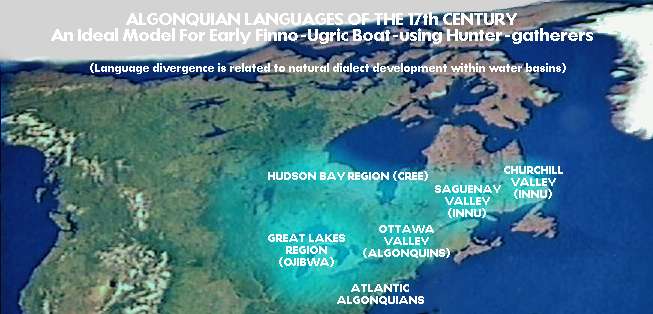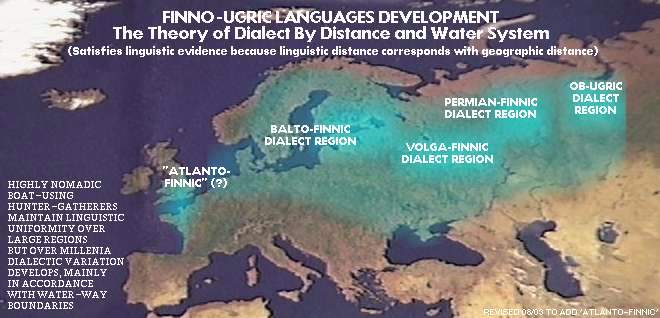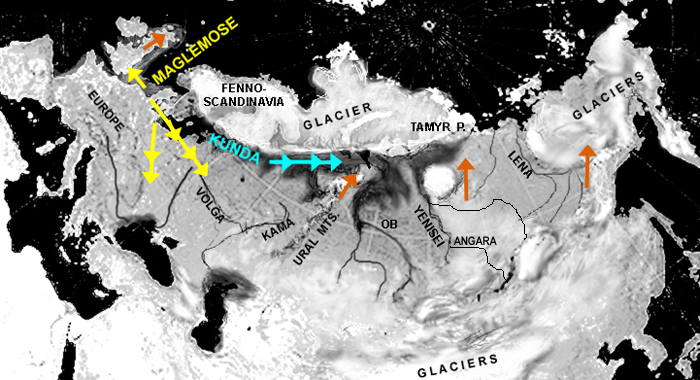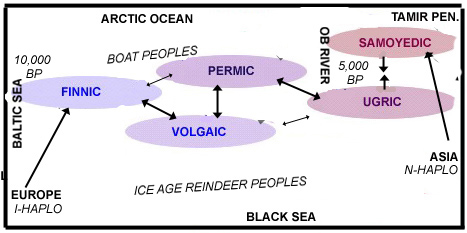THE NATURAL
DIVISION AND SUBDIVISION ACCORDING TO WATER GEOGRAPHY OF BOAT-BASED
HUNTER-GATHERERS
Figure 1
A RECENT EXAMPLE OF LARGE WATER SYSTEM DIVISIONS NATURALLY FORMED
IN SEASONALLY NOMADIC BOAT (CANOE) USING HUNTER-GATHERERS. THEIR OWN
LEGENDS SPEAK OF ORIGINS IN THE VICINITY OF THE EASTERN COAST AREA WITH
THEIR EXPANSION BEING VIA MAINLY INTO THE GREAT LAKES

It is possible to refer to the situation that existed
in eastern Canada when the European colonists arrived. The Algonquian
language family tribes each occupied large water systems - Labrador
Innu in the Churchill River, Saguenay Innu in the Saguenay River
system, Ottawa Algonquins in the Ottawa River valley, several
Ojibwa (Anishnabe) tribes in water basins draining into the Great Lakes
from the north side. Since water systems are quite large, each
one contains a 'people', which will subdivide into sub-systems such as
several tribes in several groupings of rivers draining into for example
the Cree into Hudson Bay, or Ojibwa into the waters of the upper Great
Lakes. There is a natural
subdividing of boat-based hunter-gatherers according to the geography
of water systems
For example . there is a perfect example in the
Mississauga subdivision of the Anishnabe/Ojibwa Algonquian peoples
around the several Great Lakes water basins. The specific tribe or
sub-people occupied the entire Trent River
water system that drained the waters of the Kawartha Lakes towards Lake
Ontario. In that instance, the specific tribe covered a
region as
long as 400 km. They formed a tribe of the Mississaugas. There were
also Ojibwa in waters draining into Lake Huron from the east, or from
the north, and additionally into Lake Superior. It was the the water
geography that grouped the peoples together, and once the groupings
became established, there was soft separation from adjacent tribes,
which allowed the development of small individual dialectic
peculiarities compared to neighbours, but because boat-based way of
life, and sometimes gatherings of tribes (called "pow-wows") the
divergence in seasonally nomadic hunter-gatherer peoples was small.
However, when we consider the large scale water systems (Hudson Bay
Cree in waters draining into the south half of Hudson Bay; Ojibwa
(Anishnabe) in waters draining into Lake Ontario from the north, the
Ottawa Algonquins in the waters of the large Ottawa River, and so
on...) the linguistic groupings from the separation bordered on the
dialects being languages. For example the Ojibwa of Lake Superior might
make fun of some Cree words and vice versa, but the languages were
close enough that in regions of contact like Sioux Lookout, a hybrid
language developed they call "Oji-Cree".
In general most of the "Algonquian" family (as
linguists call this whole family) is defined by expansion from the east
into the Great Lakes water system, however some of the Algonquians on
the coast from Newfoundland south to New England, appear to have become
established via travelling up rivers from the Atlantic. This - as
suggested in the UIRALA articles - seems to suggest these peoples have
an origin in peoples with connection to seagoing skin boat peoples, who
perhaps descended from the "Dorset Culture" which was pushed out of the
northeast arctic by immigration of "Thule Culture".
Figure 2
SUGGESTED SIMILAR BOAT PEOPLES NATURALLY DEVELOPING DIALECTIC
LINGUISTIC DIVISIONS ACCORDING TO WATER SYSTEMS BASED ON ARCHEOLOGICAL
EVIDENCE OF THE SPREAD OF "MAGLEMOSE" and "KUNDA" BOAT CULTURES FROM
SOUTH SCANDINAVIA

In the above map, the blue represents the regions in
which the nomadic boat peoples moved throughout the year. There were no
sharp permanent boundaries, and each large scale water system could
naturally subdivide further, producing several tribes. It is the water
geography that determined what nomadic extended families become
associated with what other families to represent the tribe of that
particular water geography It is possible, with information about ther
recent Algonquian divisions in Figure 1, to look at maps of water
geography in the entire region, and get a good sense of where the
tribes were located and even where there were gathering places for
extended families of a tribe, and also several neighbouring tribes.
Furthermore, the Canadian Alqonquian experience shows that these
peoples, not bound by any formal political organization, are influenced
to group themselves into natural tribes purely from water geography. As
civilization progressed in Europe, external influences promoted the
establishing of towns, the arrival of trade, and attempts at farming.
These new activities narrowed the range of movements that sharpened the
divisions. Dialectic difference between neighbours that were very
small when they were boat-using and fully nomadic, became large
dialectic differences. For example in the Baltic Finnic region we are
today aware of two major languages - Estonian and Finnish. These
languages are defined by the creation of political nations and the
standardization of the language. Before the political divisions there
would have been a continuum of dialects from the southeast Baltic
northward into Finland. This continuum would have been punctuated by
divisions ultimately caused by water systems which also affected
orientation for trade. For example there would have been an
Estonian-like dialect at the mouth of the Vistula, going north, a
dialect in the Neemen River (The Lithuanians were originally the Leedu,
peoples of the sandbars) and next peoples of the Venta River and
Curonian Peninsula, next peoples of the Daugava (Finnic Vaina) River
who were the Livonains, next peoples of the Pärnu River, and we could
go on through Estonia towards the Narva Region and then around the Guff
of Finland to a south Finnish people, a west Finnish people, and so
on-- maybe a hundred dialects when reaching the reindeer peoples. These
were a natural continuum divided by the natural desire of peoples to
group families into at least a small tribe, and that grouping would be,
for boat peoples, determined by water systems. If on the sea, the
circumstances of coastal geography, prevailing winds, etc dictated the
way extended families because clustered into tribes.
The modern Finno-Ugric languages developed
from a condensation from political and trade forces of the numerous
dialectic divisions into a fewer number of strong dialects that became
related languages. The Canadian Algonquian situation appears to have
developed a considerable time ago, but because there never was any net
population growth, and no intrusion of outside forces until recently,
the early "primitive" situation survived there. In the west Eurasian
experience, we can still find some of the original natural organization
of water-based peoples by water geography in the Ob-Ugrians on the Ob,
where remains of what we see in the Canadian Algonquian experience, are
still found. Just as the Algonquians still have remains of their
birch-bark canoes, so too the Ob-Ugrians who have kept up connections
to their traditional tribal origins, which include still making their
dugout canoes.
Side-note: there are Finnish
linguists who are so closely tied to a linguistics-based belief that
the regions between Scandinavia and the Urals originally had some
earlier Paleo-language, and that the Finno-Ugric languages replaced
them. The fact that Finno-Ugric languages preserve the intimate
connections to an ancient boat-oriented way of life, and even subdivide
in ways that echo ancient origins in natural tribal divisions according
to water geography, prove that the Finno-Ugric languages must have
developed from the languages of the boat peoples, originating
ultimately in the "Maglemose" and "Kunda" archeological cultures at the
end of the Ice Age. If an original unknown language was replaced by
"Finno-Ugric", these echoes with the boat-people past would no longer
be found, since language is an aspect of culture, and replacement of
language will also be accompanied by replacement of other aspects of
culture. An example where such replacement really occurred, would be
the arrival of farming culture towards the south.
SOME ADDITIONAL
DETAILS: THE INTERRACTION BETWEEN BOAT PEOPLES ORIGINATING FROM EUROPE
AND REINDEER PEOPLES ORIGINATING GROM ASIA
Figure
4
ORANGE ARROWS SHOW ROUTES TAKEN BY REINDEER HERDS AND FOLLOWED BY
REINDEER HUNTERS. THE ASIAN REINDEER HUNTERS CARRIED DIFFERENT
N-HAPLOGROUPS, ONE BRANCH OF WHICH ENTERED NORTHEAST EUROPE

This map of Eurasia shows the two archeologically
well-documented cultures "Maglemose" and "Kunda" cultures that expanded
as the climate warmed, following all the waterways easily accessed from
the Baltic. The orange arrows suggest locations where reindeer herds
successfully reached the arctic. Obviously in northern Europe, all the
reindeer tundra disappeared. Pure logic alone suggests that when the
glaciers were gone, and the coastline returned to what it is today, the
tundra return and Samoyedic reindder peoples and reindeer herds would
have been able to migrate west along the northern coast, and reach
northern Finland. The Saami peoples may have come from this migration.
Since the glaciers covered Scandinavia, it is unlikely reindeer people
managed to enter northern Scandinavia any earlier. This migration,
perhaps around a millenium or two after the time shown in the map,
would have carried the N3 haplogroup west. It then later diffused south
into the Finno-Ugric peoples.
Figure 5
A GRAPHIC SHOWING HOW BOAT PEOPLES EXPANDED EAST IN THE FOREST
ZONE, WHILE REINDEER PEOPLES AND REINDEER HERDS EXPANDED WEST WHEN THE
REINDEER TUNDRA HAD BEEN RESTORED IN NORTHERN EUROPE

The
above diagram, intends to show diffusion of language elements,
genetics, etc in a radiating fashion. The solid arrows are intended to
show actual people movements. We do not know if the reindeer people
were the Samoyeds, or the carriers of the N3 haplogroup, or both. But
this diagram shows the general idea as shown in two arrows in Figure 3
- that the Uralic languages group is a merging of European and Asian
traditions. It does not suggest any replacement of either
original boat people language, nor reindeer peoples language, but
a general exchange. To understand the entire linguistic situation
let us imagine that first the original Finno-Ugric language at the Ob
River, changed dramatically from Samoyedic influence, and then through
the normal two way exchanges between dialectic regions, the Samoyedic
elements to some small degree enter the next dialect - Permic - and
then the change in Permic influence the Volgic, and so on - which can
be viewed as diffusion of Samoyedic elements (language elements,
cultural elements, genetic elements).


















